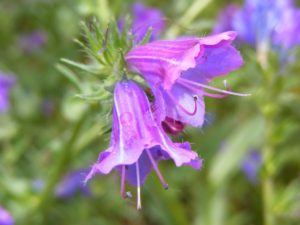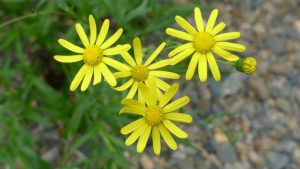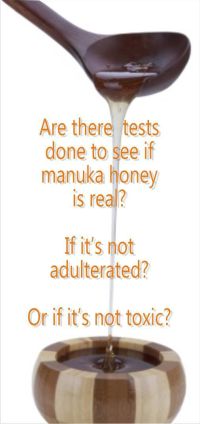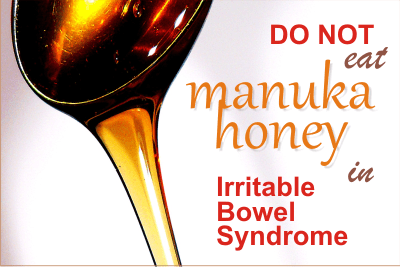It turns out that sometimes our excellent, amazing honey can poison us. It is possible when it is contaminated with nectar from toxic plants, which can grow everywhere. Can we know if our raw honey is safe or not? How do they poison us? Should we stop eating honey, though we know it is so healthy for our bodies?
Research says Australian honeys are more toxic than other honeys. Does this mean we should stop eating manuka or leatherwood honey? Are some of them tested so we know for sure?
The Irish research
A 2014 research, published by Food Additives and Contaminants Journal was done on Australian and New Zealand honey samples sourced from supermarkets in Australia. Analysis showed that 41 of the 59 honey samples were contaminated with toxins from weeds such as Patterson’s curse and fireweed.
• The toxins were pyrrolizidine alkaloids (PAs) with the mean total sum of PAs of 153 µg per kg per day (the predominant being found in 76% and 88% were Echimidine and lycopsamine.)
The average daily exposure were 0.051 µg per kg per day for adults and 0.204 µg per kg per day for children.
Which is A LOT, considering the maximum daily PA intake limit of 0.007 µg per kg per day, as it is proposed by European Food Safety Authority (EFSA), Committee on Toxicity (COT) and Bundesinstitut für Risikobewertung (BfR – Federal Institute of Risk Assessment Germany).
Which means that by consuming those honeys, the average daily exposure to this toxin, for the adult population (60 kg/adult), is increased by a factor of 7 and that of the child population (15 kg/child) by a factor of 29.
• Another set of samples, of honeys originating from Australia and New Zealand but sourced in Ireland, found that they had comparable quantities of PAs.
• Another survey made in Ireland on other honeys, not originating from Australia and New Zealand, had the average PA concentration of 40 µg per kilogram, significantly lower than the two sample sets. Yet, above the proposed European limit.
The high probability of PAs in honey, has been confirmed by recent studies such as of: Dübecke et al. 2011; Kempf et al. 2011; Orantes-Bermejo et al. 2013; Martinello et al. 2014; Griffin et al. 2014b.
What did the Australians say?
1. The Australian Honeybee Industry Council’s Trevor Weatherhead said that those claims were based on outdated research, relying on samples collected between 2008 and 2012.
2. The samples met Australia’s current food safety standards, which allow honey sourced from restricted plants to be sold as long as it is diluted through blending with other honey.
The blending approach used in Australia is out of step with other world health authorities such as the European Food Safety Authority, the UK Committee on Toxicology and the German Institute for Risk Assessment who direct against the dilution of contaminated food. The latter has criticised the Australian approach as “counterproductive”.
ANZ’s level of safe intake for pyrrolizidine alkaloids is set much higher than its European counterparts. The European tolerable intake is 0.007 micrograms per kilogram of body weight, per day. The Australian intake is 1 microgram per kilogram of body weight, per day.
Why this huge difference? Aren’t Australians belonging from the same human race as the rest of the world? Are they too careless or Europeans too cautious? What should we do then?
3. However, Food Standards Australia New Zealand have stated that this limit is to be reduced, most likely in line with the proposed 0.007 µg kg body weight/day.
4. Australians say: “The truth is that in Australia we produce some of the cleanest honey in the world, collected in our pristine native forests.”
Well, it is true, indeed. True that they produce some of the most tastiest and healthiest honey on the world. The most powerful antimicrobial honey for wounds and skin infections is manuka honey. Kanuka honey is the best for acne and rosacea. But even with these excellent honeys there is still the chance of them being poisoned with a toxin found in tutu bushes. (see A new dispute on manuka honey market: Is it toxic or not?)
It happened in the past. And for this reason there are more drastic laws, honeys should be tested before putting them to market. The producers of manuka honey are now cautious, they do not place their hives near the areas with tutu bushes, because the risk of an exceeded legal level of the toxin would mean to through away all the honey. And that’s not something to ignore.
The safest Australian honeys, tested in the research, with a PAs concentration below the European standard are: Tasmanian Leatherwood, Gum Honey, Yellow Box, Mudgee Honey, Red Gum honey, Winterflower Honey.
Coming back to the samples of honey discussed in the research, the plants that contaminated them were:
Patterson’s curse
 Patterson’s curse (Echium plantagineum), aka Salvation Jane Blueweed, Lady Campbell Weed, Riverina Bluebell, and Purple Viper’s Bugloss, is indeed an invasive plant in Australia. It’s easy to guess that contamination is easily possible.
Patterson’s curse (Echium plantagineum), aka Salvation Jane Blueweed, Lady Campbell Weed, Riverina Bluebell, and Purple Viper’s Bugloss, is indeed an invasive plant in Australia. It’s easy to guess that contamination is easily possible.
Patterson’s curse contains pyrrolizidine alkaloids and is poisonous. When eaten in large quantities, it is considered to be poisonous to grazing livestock, especially those with simple digestive systems, like horses. It can also irritate the udders of dairy cows and the skin of humans.
The toxins are cumulative in the liver, and death may result from too much Paterson’s curse in the diet.
From the same Echium family, comes Viper’s Bugloss (Echium vulgare), which is the most common of them. Also known as blueweed, blue thistle, blue devil, snake flower or snake’s tongue. Viper’s Bugloss is biennial, with a single unbranched flowering stem and smaller, more blue flowers, but is otherwise similar. This plant, also considered an invasive weed, also containing PAs, gives us Viper’s Bugloss honey.
But there is a warning about this honey: It should be eaten only in small quantities, not on a regular basis, and totally avoided by pregnant, lactating women and infants or by persons with compromised liver function.
Fireweed
 Fireweed (Senecio madagascariensis) is a 13-petalled, yellow-flowering daisy-like plant that is toxic to most livestock, although it can be tolerated by goats and sheep. It is on the noxious weed list for Hawaii and the reject list for Australia.
Fireweed (Senecio madagascariensis) is a 13-petalled, yellow-flowering daisy-like plant that is toxic to most livestock, although it can be tolerated by goats and sheep. It is on the noxious weed list for Hawaii and the reject list for Australia.
Fireweed is largely restricted to the south-eastern coast of Australia and has established along the entire NSW coast. All parts of the plant at all stages of growth are toxic. Hay, silage or grain that is contaminated with fireweed plants or their seeds can also be toxic.
The liver damage caused by fireweed is irreversible and there is no antidote for toxic pyrrolizidine alkaloids. Symptoms of poisoning from fireweed include gradual weight loss, jaundice, fluid in the lungs, blindness, sudden death without any other indications.
What are Pyrrolizidine alkaloids?
Pyrrolizidine alkaloids are produced by plants as a defense mechanism against insect herbivores. 3% of the world’s flowering plants contain pyrrolizidine alkaloids. Besides honey, pyrrolizidine alkaloids can also be found in grains, milk, offal and eggs.
In Middle and Northern Europe these pollens are not among the main pollen gathered by bees, however in Southern Europe, the two Echium plants (Echium vulgare and Echium plantagineum) are more diffused and are gathered by bees in larger amounts.
Recently Kempf et al. (2010) reviewed the importance of PA’s (pyrrolizidine alkaloids) for human nutrition. The quantities found in Echium, Senecio, Eupatrium and Phalaenopsis pollen varied between 0.8 and 14 mg/g.
From all Pyrrolizidine alkaloids, the unsaturated pyrrolizidine alkaloids are damaging to the liver (hepatotoxic).
How dangerous are these pyrrolizidine alkaloids for humans?
Here is a medical explanation: “In humans, poisoning with 1,2-unsaturated PAs (pyrrolizidine alkaloids) is described as acute hepatic veno-occlusive disease (HVOD), characterized by rapidly developing and progressing symptoms of upper abdominal discomfort, dragging pain in the right hypochondrium, ascites, and sometimes oliguria and oedema of the feet. Nausea and vomiting may be present. Jaundice and fever are rare. There is generally gross, tender, smooth hepatomegaly, often accompanied by massive pleural effusion and sometimes slight splenomegaly and minimal ankle oedema. (…) The acute disease is associated with high mortality, and a subacute or chronic onset may lead to liver cirrhosis. Death often occurs after oesophageal haemorrhage.”
“However, epidemiological studies to assess the carcinogenic role of pyrrolizidine alkaloids for man are not available.”
Available clinical and experimental data suggest that a single episode of PA toxicity and possibly also a longterm low level exposure may lead to cirrhosis of the liver. Toxic, unsaturated PAs could also be possible carcinogens in man, since a number of them have been demonstrated to induce cancer in experimental animals.
The lowest intake rate causing VOD (veno-occlusive disease) in a human being was estimated to be 0.015 mg/kg bw/day, and was a result of a self medication with a comfrey preparation.
Low level, intermittent dietary exposure to toxic, unsaturated PAs can be expected, so that slowly progressing chronic diseases such as cancer, cirrhosis and pulmonary hypertension are possible outcomes from eating foods sometimes containing relatively low levels of PAs.
But it’s not only about honey! There are PAs in food and herbal medicinal products.
And we are not able to avoid them. There are in foods of animal origin (milk, eggs, meat, pollen products), in grain and in packed lettuce boxes as recently detected in Germany [MOLYNEUX et al. 2011], salads, teas, spices.
Exposure to PAs from pollen and herbal dietary supplements can potentially be very much higher than dietary exposure from honey. Certain herbal products are known to have caused human illness. Data on PAs in herbal dietary supplements in the EU market are generally not available.
However, if such supplements are prepared from PA-containing plants, then they could present a risk of both acute and chronic effects in the consumer. Borage oil and Echium oil marketed as dietary supplements, and salad crops contaminated with PA-plants such as Senecio vulgaris (common groundsel), could present a risk to the consumer, but data are not available.
There is Patterson’s curse seed oil on the market!
Borage and Echium seed oils are used and sold as food supplements (mainly in capsules) in drugstores and internet-shops, but again no levels of consumption or PA-levels are known for these products. Which is why, an estimation of the contribution of these products to human PA exposure is not possible.
European Commission has approved refined Echium plantagineum seed oil as a new food ingredient. The total PA-content is limited to 4 µg/kg (Commission Decision 2008/558/EC9).
PAs are also present in Chinese medicines
A total of 50% herbal teas and 78% Chinese medicines tested positive for one or more PAs and/or PANOs included within this study, ranging from 10 to 1733 and from 13 to 3668 µg kg−1, respectively. (study source).
Yet, the HMPC concluded that the short-time (maximum 14 days) daily intake of 0.35 µg toxic, unsaturated PAs/day from herbal medicinal products might be acceptable.
Low level, intermittent dietary exposure to toxic, unsaturated PAs can be expected, so that slowly progressing chronic diseases such as cancer, cirrhosis and pulmonary hypertension are possible outcomes from eating foods sometimes containing relatively low levels of PAs.
Usual toxic plants that contaminate our honey and food:
Senecio madagascariensis (Australia, Hawaii) and Senecio jacobaea (Germany, UK, USA, New Zealand) which create serious problems for animals and via animal products, for humans as well.
There are 13 families of the flowering plants contain PAs, but from them only 6 contain hepatotoxic PAs. They represent only 3% of all the species of flowering plants (Culvenor, 1980).
The principal families involved: Asteraceae (Compositae), Boraginaceae and Leguminaceae (Fabaceae),
while the main genera are Senecio (Asteraceae), Crotalaria (Leguminaceae), Heliotroprium, Trichodesma
Symphytum (Boraginaceae).
In Australia Echium plantagineum (Boraginaceae) is the most poisonous species. All three families are well represented in Australia and are causes of poisoning in grazing domestic livestock in all parts of the country (Seawright, 1989).
Several Crotalaria spp. cause poisoning in cattle and horses in northern Australia while
Heliotropium spp, Echium plantaginium and various Senecio spp. are responsible for toxicity in sheep, cattle and horses in southern Australia (Seaman & Walker 1985).
Pigs (Hooper & Scanlan, 1977; Jones et al, 1981) and poultry (Ross & Tucker, 1977; Pass et al, 1979) have also become poisoned due to consumption of prepared feeds contaminated with the seeds of Heliotropium europaeum and Crotalaria retusa respectively.
Conclusions:
- Monofloral honeys are more safe. Nectar is harvested from only one type of flower and its abundance will keep bees away from other unwanted poisonous plants.
- Since there is no international standard regarding the allowed concentration of PAs, jars of honey do not label it, and we may assume that the respective patch is not even tested for it.
- PAs are not only in honey. They can also be in milk, eggs, meat, salads, spices, teas and grains. To all these we add those found in some honeys. This is why we need to know the honey we eat does not contain them.
- Herbal medicinal products may also contain PAs. Keep your daily intake to a maximum 14 days.
- Processing honey doesn’t mean a honey free of PAs. They are still there.
- Some Australian honeys are more dangerous than the other honeys.
- Paranoia never helped. There are not so many poisonous plants everywhere. If we live in the country, we know them and know if beekeepers have their hives near them. If we don’t and we need to buy honey from shops, let’s buy monofloral honeys, which are safer.
- Manuka honey is tested for the toxin tutin, which can contaminate it. It is safe.
Further reading:
• Scientific Opinion on Pyrrolizidine alkaloids in food and feed, European Food Safety Authority (EFSA), Parma, Italy
• PYRROLIZIDINE ALKALOIDS IN FOOD published by AUSTRALIA NEW ZEALAND FOOD AUTHORITY;
• Public statement on the use of herbal medicinal products containing toxic, unsaturated pyrrolizidine alkaloids (PAs), publiched in 2014 by European Medicines Agency.
Related posts on toxic honey:
• A new dispute on manuka honey market: Is it toxic or not?
• Himalayan Red Honey – aka mad, toxic, hallucinogenic honey from Nepal.
******
******
References:
– http://www.abc.net.au/news/2016-01-21/australian-beekeepers-say-contamination-claims-are-misleading/7104680
– http://www.smh.com.au/national/australian-honey-could-be-making-us-sick-20160120-gm9u6f.html
– http://www.tandfonline.com/doi/full/10.1080/19440049.2014.996789
Patterson’s curse – picture credit Peripitus – Own work, CC BY-SA 3.0, via commons wikimedia;
Fireweed flowers – picture credit John Tann, published under CC via flickr.com



